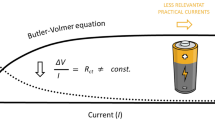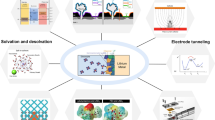Abstract
Conductivities were measured for the ternary systems NaNO3–KNO3–H2O, NaCl–BaCl2–H2O, NaCl–LaCl3–H2O, and their binary subsystems NaNO3–H2O, KNO3–H2O, NaCl–H2O, BaCl2–H2O, and LaCl3–H2O at (293.15, 298.15 and 303.15) K. The results were used to verify the generalized Young’s rule and the semi-ideal solution theory. Comparison of the results shows that the average relative differences between the predicted and measured conductivities are ≤4.2×10−3 for NaNO3–KNO3–H2O, ≤4.6×10−3 for NaCl–BaCl2–H2O, and ≤8.9×10−3 for NaCl–LaCl3–H2O, indicating that the generalized Young’s rule and the semi-ideal solution theory can provide good predictions for the conductivity of mixed electrolyte solutions in terms of the data from their binary subsystems.
Similar content being viewed by others
References
Miller, D.G.: Binary mixing approximations and relations between specific conductance, molar conductance, equivalent conductance, and ionar conductance for mixtures. J. Phys. Chem. 100, 1220–1226 (1996). doi:10.1021/jp951157u
Hu, Y.F., Lee, H.: Prediction of viscosity of mixed electrolyte solutions based on the Eyring’s absolute rate theory and the semi-ideal hydration model. Electrochim. Acta 48, 1789–1796 (2003). doi:10.1016/S0013-4686(03)00226-3
Hu, Y.F.: Prediction of viscosity of mixed electrolyte solutions based on the Eyring’s absolute rate theory and the equations of Patwardhan and Kumar. Chem. Eng. Sci. 59, 2457–2464 (2004). doi:10.1016/j.ces.2003.11.005
Li, Z.B., Li, Y.G., Lu, J.F.: Surface tension model for concentrated electrolyte aqueous solutions by the Pitzer equation. Ind. Eng. Chem. Res. 38, 1133–1139 (1999). doi:10.1021/ie980465m
Andrzej, A., Malgorzata, M.L.: Computation of electrical conductivity of multicomponent aqueous systems in wide concentration and temperature ranges. Ind. Eng. Chem. Res. 36, 1932–1943 (1997). doi:10.1021/ie9605903
Young, T.F., Wu, Y.C., Krawetz, A.A.: Thermal effects of the interactions between ions of like charge. Discuss. Faraday Soc. 24, 37–42 (1957). doi:10.1039/df9572400037
Young, T.F., Wu, Y.C., Krawetz, A.A.: General discussion. Discuss. Faraday Soc. 24, 66–82 (1957). doi:10.1039/df9572400037
Hu, Y.F.: The thermodynamics of nonelectrolyte systems at constant activities of any number of components. J. Phys. Chem. B 107, 13168–13177 (2003). doi:10.1021/jp035528f
Hu, Y.F., Fan, S.S., Liang, D.Q.: The semi-ideal solution theory for mixed ionic solutions at solid-liquid-vapor equilibrium. J. Phys. Chem. A 110, 4276–4284 (2006). Medline doi:10.1021/jp0542672
Hu, Y.F., Zhang, Z.X., Zhang, Y.H., Fan, S.S., Liang, D.Q.: Viscosity and density of the nonelectrolyte system mannitol + sorbitol + sucrose + H2O and its binary and ternary subsystems at 298.15 K. J. Chem. Eng. Data 51, 438–442 (2006). doi:10.1021/je0503608
Hu, Y.F.: New predictive equations for the specific and apparent molar heat capacities of multicomponent aqueous solutions conforming to the linear isopiestic relation. Bull. Chem. Soc. Jpn. 74, 47–52 (2001). doi:10.1246/bcsj.74.47
Wu, Y.C., Koch, W.F., Zhong, E.C., Friedman, H.L.: The cross-square rule for transport in electrolyte mixtures. J. Phys. Chem. 92, 1692–1695 (1988). doi:10.1021/j100317a060
Hu, Y.F., Zhang, X.M., Li, J.G., Liang, Q.Q.: The semi-ideal solution theory. 2. Extension to conductivity of mixed electrolyte solutions. J. Phys. Chem. B 112, 15376–15381 (2008). Medline doi:10.1021/jp805833g
Hu, Y.F., Wang, Z.C.: Isopiestic studies on (NaCl + NH4Cl + BaCl2)(aq) at the temperature 298.15 K. A quaternary system obeying Zdanovskii’s rule. J. Chem. Thermodyn. 26, 429–433 (1994). doi:10.1006/jcht.1994.1052
Vogel, A.I., Bassett, J.: Vogel’s Textbook of Quantitative Inorganic Analysis: Including Elementary Instrumental Analysis, 5nd edn. Longman, Essex (1989)
Ruby, C.E., Kawai, J.: The densities, equivalent conductances and relative viscosities at 25°C, of solutions of hydrochloric acid, potassium chloride and sodium chloride, and of their binary and ternary mixtures of constant chloride-ion-constituent content. J. Am. Chem. Soc. 48, 1119–1128 (1926). doi:10.1021/ja01416a001
Isono, T.: Density, viscosity, and electrolytic conductivity of concentrated aqueous electrolyte solutions at several temperatures. Alkaline-earth chlorides, LaCl3, Na2SO4, NaNO3, NaBr, KNO3, KBr, and Cd(NO3)2. J. Chem. Eng. Data 29, 45–52 (1984). doi:10.1021/je00035a016
Robinson, R.A., Stokes, R.H.: Electrolyte Solutions, 2nd edn. Butterworth, London (1965)
Zdanovskii, A.B.: Regularities in the property variations of mixed solutions. Tr. Solyanoi Lab. Akad. Nauk SSSR 6, 5–70 (1936)
Author information
Authors and Affiliations
Corresponding author
Rights and permissions
About this article
Cite this article
Zhang, XM., Hu, YF., Peng, XM. et al. Conductivities of Several Ternary Electrolyte Solutions and Their Binary Subsystems at 293.15, 298.15, and 303.15 K. J Solution Chem 38, 1295–1306 (2009). https://doi.org/10.1007/s10953-009-9448-6
Received:
Accepted:
Published:
Issue Date:
DOI: https://doi.org/10.1007/s10953-009-9448-6




